牛津8B英文全套教案3
牛津英语8B_Unit3_Online_Travel_单元分析及课时教案
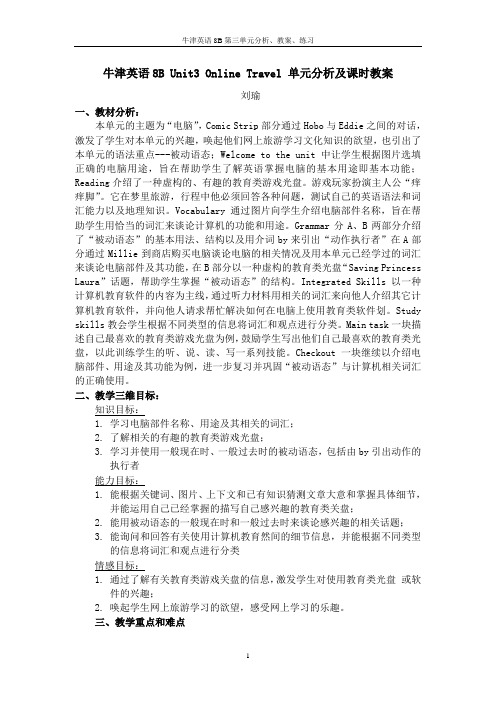
牛津英语8B Unit3 Online Travel 单元分析及课时教案刘瑜一、教材分析:本单元的主题为“电脑”,Comic Strip部分通过Hobo与Eddie之间的对话,激发了学生对本单元的兴趣,唤起他们网上旅游学习文化知识的欲望,也引出了本单元的语法重点---被动语态;Welcome to the unit 中让学生根据图片选填正确的电脑用途,旨在帮助学生了解英语掌握电脑的基本用途即基本功能;Reading介绍了一种虚构的、有趣的教育类游戏光盘。
游戏玩家扮演主人公“痒痒脚”。
它在梦里旅游,行程中他必须回答各种问题,测试自己的英语语法和词汇能力以及地理知识。
Vocabulary通过图片向学生介绍电脑部件名称,旨在帮助学生用恰当的词汇来谈论计算机的功能和用途。
Grammar分A、B两部分介绍了“被动语态”的基本用法、结构以及用介词by来引出“动作执行者”在A部分通过Millie到商店购买电脑谈论电脑的相关情况及用本单元已经学过的词汇来谈论电脑部件及其功能,在B部分以一种虚构的教育类光盘“Saving Princess Laura”话题,帮助学生掌握“被动语态”的结构。
Integrated Skills以一种计算机教育软件的内容为主线,通过听力材料用相关的词汇来向他人介绍其它计算机教育软件,并向他人请求帮忙解决如何在电脑上使用教育类软件划。
Study skills教会学生根据不同类型的信息将词汇和观点进行分类。
Main task一块描述自己最喜欢的教育类游戏光盘为例,鼓励学生写出他们自己最喜欢的教育类光盘,以此训练学生的听、说、读、写一系列技能。
Checkout 一块继续以介绍电脑部件、用途及其功能为例,进一步复习并巩固“被动语态”与计算机相关词汇的正确使用。
二、教学三维目标:知识目标:1.学习电脑部件名称、用途及其相关的词汇;2.了解相关的有趣的教育类游戏光盘;3.学习并使用一般现在时、一般过去时的被动语态,包括由by引出动作的执行者能力目标:1.能根据关键词、图片、上下文和已有知识猜测文章大意和掌握具体细节,并能运用自己已经掌握的描写自己感兴趣的教育类关盘;2.能用被动语态的一般现在时和一般过去时来谈论感兴趣的相关话题;3.能询问和回答有关使用计算机教育然间的细节信息,并能根据不同类型的信息将词汇和观点进行分类情感目标:1.通过了解有关教育类游戏关盘的信息,激发学生对使用教育类光盘或软件的兴趣;2.唤起学生网上旅游学习的欲望,感受网上学习的乐趣。
牛津英语8B Unit3 Fishing with birds说课稿
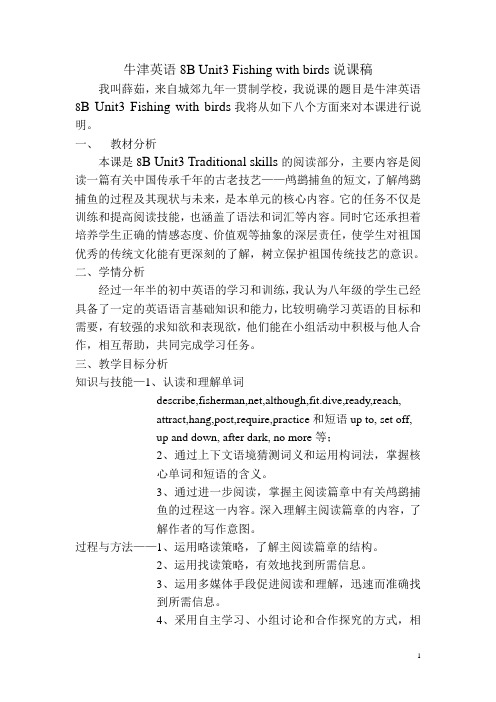
牛津英语8B Unit3 Fishing with birds说课稿我叫薛茹,来自城郊九年一贯制学校,我说课的题目是牛津英语8B Unit3 Fishing with birds我将从如下八个方面来对本课进行说明。
一、教材分析本课是8B Unit3 Traditional skills的阅读部分,主要内容是阅读一篇有关中国传承千年的古老技艺——鸬鹚捕鱼的短文,了解鸬鹚捕鱼的过程及其现状与未来,是本单元的核心内容。
它的任务不仅是训练和提高阅读技能,也涵盖了语法和词汇等内容。
同时它还承担着培养学生正确的情感态度、价值观等抽象的深层责任,使学生对祖国优秀的传统文化能有更深刻的了解,树立保护祖国传统技艺的意识。
二、学情分析经过一年半的初中英语的学习和训练,我认为八年级的学生已经具备了一定的英语语言基础知识和能力,比较明确学习英语的目标和需要,有较强的求知欲和表现欲,他们能在小组活动中积极与他人合作,相互帮助,共同完成学习任务。
三、教学目标分析知识与技能—1、认读和理解单词describe,fisherman,net,although,fit.dive,ready,reach,attract,hang,post,require,practice和短语up to, set off,up and down, after dark, no more等;2、通过上下文语境猜测词义和运用构词法,掌握核心单词和短语的含义。
3、通过进一步阅读,掌握主阅读篇章中有关鸬鹚捕鱼的过程这一内容。
深入理解主阅读篇章的内容,了解作者的写作意图。
过程与方法——1、运用略读策略,了解主阅读篇章的结构。
2、运用找读策略,有效地找到所需信息。
3、运用多媒体手段促进阅读和理解,迅速而准确找到所需信息。
4、采用自主学习、小组讨论和合作探究的方式,相信学生,激发他们的学习欲望和动力,发现问题并解决问题。
情感态度与价值观——树立保护祖国传统技艺的意识。
牛津英语8BUnit3Grammar的教案

To use the simple past tense and present perfect tense to talk about events
【教学难点】
To understand adverbs of time and use them correctly
【教学过程】
教学过程
二次备课
3.Do thesupplementary task
(1)A: I’ve seen the film The Sound of Music already.
B: When ____ you ____ it?
A: the day before yesterday.
A have; seen B will ;see C did, see D did, seen
1.Finish Part B and then discuss the answers.
2.T: Now you’ve learnt a lot about the two tenses. Look at Part D and help Millie complete her entry with the correct forms of the verbs in the box. Check the answers and read the diary.
A Have you been B Have you gone
C Did you go D Will you go
(5)I will not go to see the film tonight because I ____ my ticket.
A didn’t lose B have lost C will lose D didn’t have
牛津教材8BChapter3教学案例

牛津教材8B Chapter3 教学案例上南北校——王守芸学生情况分析:初二(5)班是上南北校2003学年招收的一个特色班。
该校是一所普通的初级中学,生源不是很好,学生学习习惯较差,家庭教育不尽人意。
但特色班,学生的综合素质高于平行班。
我一直担任该班的英语教学工作,并曾是该班一年半的班主任。
班主任工作,使得我与该班的学生有着深厚感情基础。
容洽的师生关系为我各项英语教学任务的实施铺平了道路。
自始至终的英语教学工作,使得师生之间能互相欣赏,也使我能更好的实施短期教学目标与长期教学目标协调发展的计划。
目前的短期教学目标即应按时、按质、按量的完成教导处规定的各项教学任务,确保学生的笔试成绩。
但在接手该班时我就给自己定下了一个长期的教学目标:听说领先,读写跟上。
全面培养学生运用英语的能力。
让我的学生初中毕业时不论是笔试成绩还是口语表达能力都不输给任何一个重点中学的学生。
为了实现自己的教学目标,在预备、初一的教学过程中我引进了色拉英语、《走遍美国》,为该班学生的口语表达能力打下了扎实的基础。
从初一下学期,为了提高学生的阅读能力,我将《上海中学生英文报》引进了课堂教学,该报头版中一些原汁原味、符合中学阅读兴趣的文章使得该班的学生阅读、写作能力有了长足的进步。
总之,该班学生英语基础知识扎实、语音纯正、思维活跃、敢于、乐于用英语交流。
教学任务分析:目前大部分的英语教师对课文阅读材料的处理还只局限于对文章中生词、词语、语言点的讲解、操练以及对文章大意的理解(即True or False 选择或多项选择或回答课文问题),很少涉及让学生学会欣赏文章的语言美、结构美,所以,本学期在对初二(5)班英语教学中,我刻意将这一教学任务作为自己的教学目标。
Chapter3这课的教学阅读材料,能很好地帮助实施这一教学任务。
教学设计思路:提出问题,分析、解决问题,归纳、总结问题。
提出问题:什么样的记叙文才是一篇好的记叙文。
分析、解决问题:(生进行讨论、分析、发表见解。
牛津8B英文全套教案3

牛津8B英文全套教案3Perid6GraarIITeahinggals●Tnslidatethepresentperfettense●Tunderstandtheverbsithntinuustieadverbials TeahingpreduresStep1Havingarevisinaeadialgueliethis:A:HaveueverbeentShanghai?B:es,IhaveA:heredidugthere?B:IentthereteesagA:hendiduleaveShanghai?B:IlefttheretdasagA:Hlnghaveustaedthere?B:IhavestaedtherefrtelvedasrinpairsStep2Presentingeansa:ihasstaedinShanghaifr12dasHelefttheretdasagBu tean’tsa:ihasleftShanghaifrtdasBeauseseverbs,suhas ‘e’,‘g’and‘leave’anntbeusedithntinuustieadverbialssuhas‘frthurs’r ‘sinelastnth’Ttalabutanatinthathappenedatapintinthepast,eillhave tuse‘ag’andthesiplepasttenseStep3PratisingTellifthefllingsentenesaretruerfalseHehasbughtabiefrtears2illiebughtapursetdasag3ShehasalreadleftBeiing4ShehasbeenaafrBeiingfr2dasSheleftBeiingtdasag6SinhasinedtheReadinglubsineXX7Hisgrandfatherhasdiedfr3ears8henhavethegtarried?Step4PresentingIfuanttexpressantinuusstate,uanuseantheraliethis:Verbs Usedfrantinuusstate buhave/hashadbrrhave/haseptarrivehave/hasbeenin/at leavehave/hasbeenaainhave/hasbeenin/aeberf diehave/hasbeendead getarriedhave/hasbeenarriede/ghave/hasbeenin/at begin/starthave/hasbeennstphave/hasbeenverStepPratisingillieandSandaretalingnthephnepletethenversatinnpage 33Thenreadtgether,tringtrinpairstatitutStep6FinishingexerisesrrettheistaesinthefllingsentenesHehasbughtabiefrtears2illiehasbughtapursetdasag3ShehavealreadleftBeiing4ShehasleftBeiingfr2dasHasillieleftBeiingtdasag6SinhasinedtheReadinglubsineXX7Hisgrandfatherhasdiedfr3ears8henhavethegtarried?Step7DingheraGverhatuhavelearntbTranslatin我是三年前加入阅读兴趣小组的。
牛津译林版8B Unit3 Reading 教案
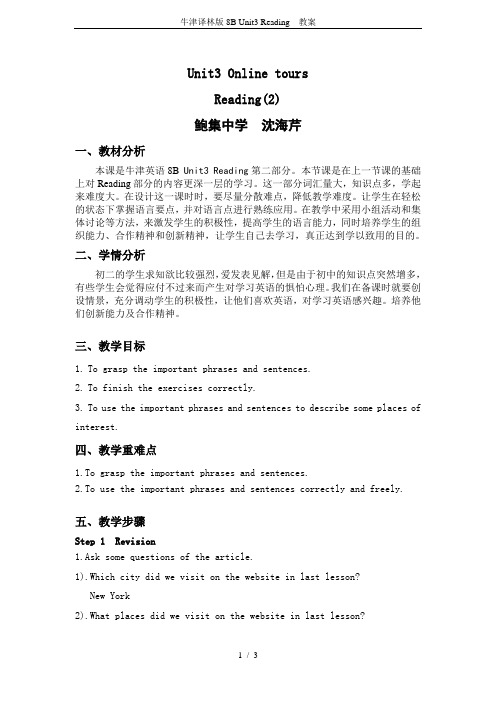
Unit3 Online toursReading(2)鲍集中学沈海芹一、教材分析本课是牛津英语8B Unit3 Reading第二部分。
本节课是在上一节课的基础上对Reading部分的内容更深一层的学习。
这一部分词汇量大,知识点多,学起来难度大。
在设计这一课时时,要尽量分散难点,降低教学难度。
让学生在轻松的状态下掌握语言要点,并对语言点进行熟练应用。
在教学中采用小组活动和集体讨论等方法,来激发学生的积极性,提高学生的语言能力,同时培养学生的组织能力、合作精神和创新精神,让学生自己去学习,真正达到学以致用的目的。
二、学情分析初二的学生求知欲比较强烈,爱发表见解,但是由于初中的知识点突然增多,有些学生会觉得应付不过来而产生对学习英语的惧怕心理。
我们在备课时就要创设情景,充分调动学生的积极性,让他们喜欢英语,对学习英语感兴趣。
培养他们创新能力及合作精神。
三、教学目标1.To grasp the important phrases and sentences.2.To finish the exercises correctly.3.To use the important phrases and sentences to describe some places of interest.四、教学重难点1.To grasp the important phrases and sentences.2.To use the important phrases and sentences correctly and freely.五、教学步骤Step 1 Revision1.Ask some questions of the article.1).Which city did we visit on the website in last lesson?New York2).What places did we visit on the website in last lesson?(设计意图:学生通过回答问题来巩固上节课我们所学的纽约的四个名胜:Wall Street,Times Square,Central Park,Broadway.并为下面具体讲解这四个地方做铺垫。
牛津初中英语 8B Unit Three 教案
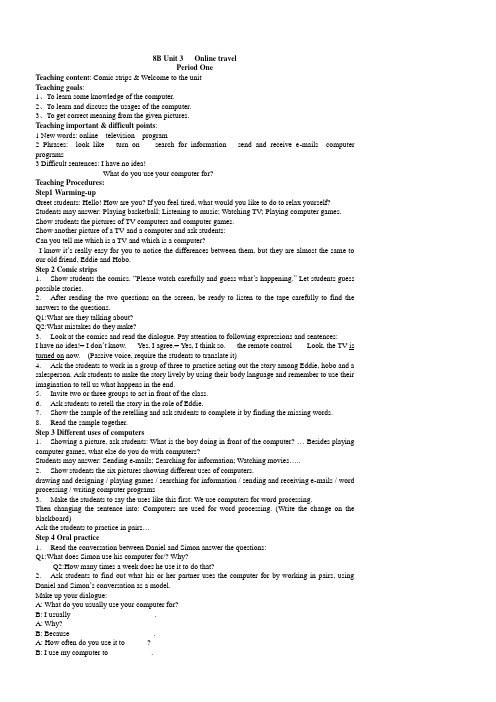
8B Unit 3 Online travelPeriod OneTeaching conten t: Comic strips & Welcome to the unitTeaching goals:1、To learn some knowledge of the computer.2、To learn and discuss the usages of the computer.3、To get correct meaning from the given pictures.Teaching important & difficult points:1 New words: online television program2 Phrases: look like turn on search for information send and receive e-mails computer programs3 Difficult sentences: I have no idea!What do you use your computer for?Teaching Procedures:Step1 Warming-upGreet students: Hello! How are you? If you feel tired, what would you like to do to relax yourself? Students may answer: Playing basketball; Listening to music; Watching TV; Playing computer games. Show students the pictures of TV computers and computer games.Show another picture of a TV and a computer and ask students:Can you tell me which is a TV and which is a computer?I know it‟s really easy for you to notice the differences between them, but they are almost the same to our old friend, Eddie and Hobo.Step 2 Comic strips1.Show students the comics. “Please watch carefully and guess what‟s happening.” Let students guess possible stories.2.After reading the two questions on the screen, be ready to listen to the tape carefully to find the answers to the questions.Q1:What are they talking about?Q2:What mistakes do they make?3.Look at the comics and read the dialogue. Pay attention to following expressions and sentences:I have no idea!= I don‟t know. Yes, I agree.= Yes, I think so. the remote control Look, the TV is turned on now. (Passive voice, require the students to translate it)4.Ask the students to work in a group of three to practice acting out the story among Eddie, hobo and a salesperson. Ask students to make the story lively by using their body language and remember to use their imagination to tell us what happens in the end.5.Invite two or three groups to act in front of the class.6.Ask students to retell the story in the role of Eddie.7.Show the sample of the retelling and ask students to complete it by finding the missing words.8.Read the sample together.Step 3 Different uses of computers1.Showing a picture, ask students: What is the boy doing in front of the computer? … Besides playing computer games, what else do you do with computers?Students may answer: Sending e-mails; Searching for information; Watching movies…..2.Show students the six pictures showing different uses of computers.drawing and designing / playing games / searching for information / sending and receiving e-mails / word processing / writing computer programs3.Make the students to say the uses like this first: We use computers for word processing.Then changing the sentence into: Computers are used for word processing. (Write the change on the blackboard)Ask the students to practice in pairs…Step 4 Oral practice1.Read the conversation between Daniel and Simon answer the questions:Q1:What does Simon use his computer for/? Why?Q2:How many times a week does he use it to do that?2.Ask students to find out what his or her partner uses the computer for by working in pairs, using Daniel and Simon‟s conversation as a model.Make up your dialogue:A: What do you usually use your computer for?B: I usually ______________________.A: Why?B: Because ______________________.A: How often do you use it to______?B: I use my computer to ___________.3.Make a survey of the uses of computers in the class to see how many students use them to play games and how many to look for information for school lessons.Please become aware of the harm computers may bring to our health and school lessons. Let‟s make good use of the modern technology.Step 5 Homework(1).Remember all the new words and expressions.(2).Read the dialogues again and again.(3).Practise the dialogues and make up new ones with your partner about computers.(4).Try to find out some other information about computers.8B Unit 3 Online travelPeriod TwoTeaching content: Reading (I)Teaching goals:1、To develop students‟ reading skills (skimming and scanning).2、To get the useful information of the text.3、To guess the meaning of words and expressions in the text.4、To gain better understanding through the framework of the material.Teaching important & difficult points:1、New words: grammar vocabulary knowledge educational traveler designer itch asleep point correctly role level reach pass mark purple2、Phrases: educational CD-ROM come out at the same time main character lie on fall asleep on the screen play the role of a map of the world3、Difficult sentences: It is designed by Nancy Jackson..Teaching Procedures:Step 1: RevisionPrepare for the following questions for one minute. Then write their answers down correctly in the exercise-books.(1)What‟re the differences between a TV and a computer?(2)Write down at least six uses of computers in our life.(3)Write down what you usually use the computer for, why and how often.Step 2: Warming-up& Presentation1.Free talk:(1)Read some of the students‟ answers to Q3 to the class… Write a wrong sentence on the blackboard: Computers used almost for searching information in my life.There are three mistakes. used---be used; almost---mostly searching---searching forTell students they are a grammar mistake and vocabulary mistakes. Both grammar and vocabulary are the knowledge of English. So if you can learn grammar and vocabulary well, you can have good knowledge of English. That‟s to say, your English will be better, or your English will reach a higher level. Ask students to read the new words:grammar vocabulary knowledge level(Take out a dictionary, a grammar book and an English novel) Tell the students that they can learn English using these books. Show the novel to the students and tell them that they can learn a lot of good qualities from it. That‟s to say, they can get much education from it. Say, the novel can educate us. Or, the novel is educational.(2)Tell the students that we can use computers to study English. Computers are very great invention to the world. They are changing almost everyone‟s life. So we say computers play an important role in our life. Do you know what role it is? It plays a role of tool of communication. Ask student to read the new words after me:role , play the role of…(3)Show a picture of a cat and ask students: What role do cats play in our life now? PetsWhat‟s wrong with the cat in the picture?Its head is itch ing. Or it has an itchy head.T:If your feet are itching,…. S: We have itchy feet.Ask students to look at the picture on the screen.T: If she loves traveling. S:She has itchy feet.T:What about you? Do you have itchy feet?Step 3: Reading1.T:I have itchy feet. And today I‟ve brought good news to you who love traveling. Now we can travel around the world in eight hours and learn English at the same time. Can you guess how we can make it? S1:We can travel around the world online.S2:We read the introductions to places in English.S3:In fact, it is a game. You can continue the game only after answering some English questions.……..T: You are very clever. Actually an educational CD-ROM takes us around the world.educational CD-ROMA CD on which large amount of information, sound and pictures can be stored for use on the computer.Let‟s listen to an article carefully to know more about it after reading the following questions.2.Listening task:Q1. Who is it designed by?Q2.What‟s the name of the main character?Q3.How many levels are there in the game?Q4.Where can you get the CD-ROM?3.Reading Task 1:Go through the passage silently, underline the words you don‟t understand and try to guess the meanings: Finish B onP444.Reading Task 2Read carefully to answer the questions:Q1:What did Itchy Feet see in his dream?Q2:How do people play the game?Q3:How does the CD-ROM help us learn English?Ask students to read the answers every twice.5.Reading Task 3:Read aloud through the Reading, then put it into several parts:Part1: The introduction to the CD-ROM.(its name; its aim and its designer)Part2: The main character and its dream.Part3: The way to play the game.Part4: Conclusion (Where you can get one)6.Ask students to deal with each part in detail.Part1: The introduction to the CD-ROM.(its name; its aim and its designer)Ask some students to read the first part, then fill in the form about the game‟s name, use and designer. Ask students to use passive voice to put the information together:The game is called Around the World in Eight Hours. It is used for learning English and geography. It was designed by Nancy Jackson.Part2: The main character and its dream.Q1: Do you know why the main character is named Itchy Feet?Q2: Can you read the words on the golden cloud with special intonation with your imagination?Make students feel free to practice reading the words in their own ways…..Part3: The way to play the game.Ask students to tell which is F and which is T.1. The travel will take you at most eight hours.2. You will see nine maps of the world after passing all levels.3. You will learn some knowledge of geography every time you reach a new place.Make students to read this part loudly….Ask students to complete the flow chart of this part…..Part4: Conclusion (Where you can get one)Step 4: Pair workAsk students to make up a conversation with his or her partner about the game.Suppose you are very interested in the CD-ROM called “Around the World in Eight Hours”, however, you want to make sure if it is worth buying. Your partner happens to know well about it. And now you are talking about the CD-ROM…Step 5: Finishing Part C2 on page 45Make students to try to complete the dialogue between Millie and Daniel according to the passage Check the answers …..Step 6: Homework:Suppose you decide to help the city bookshop to advertise the fun way to learn English by using the educational CD-ROM. Please project your design of advertisement in your exercise-book.8B Unit 3 Online travelPeriod ThreeTeaching content: Reading (II)Teaching goals:1、To learn languages points in the text.2、To gain better understanding through the framework of the material.3、To guide the students to experience the pleasure of readingTeaching important & difficult points:1、Phrases: a thirteen-year-old boy answer a question correctly by doing be sold out be marked in be written on2、Difficult sentences: You get a point every time you answer a question correctly.When you get enough points, a cloud will come down and carry you off to a place you have never visited before.This game has eight levels, and each level will take you about an hour to finish.Teaching Procedures:Step 1: RevisionShowing students a picture of the earth and saying: People say the earth is becoming smaller. Do you agree? …And why?The invention of computers and the wide use of CD-ROMs make the world smaller.T: Now you can travel around the world in eight hours online now. How can we make it? Complete the following sentences.You…… every time you answer a question correctly. When you have enough points, a cloud …… Every time you reach a new place, you will see……. Every time you pass a level, you will see……Step 2: ExplanationsExplain the language points after completing the above passage.Now let‟s talk about some details of the articles about the CD-ROM.Point1:一个新的被称为”八小时环游世界”的教育光盘刚刚发行了.A new educational CD-ROM called “Around the World in Eight Hours” has just come out.Ask students to translate the sentence. Tell them to underline the main parts of the sentence first, and make sure what tense to use. Finally, translate all the other parts.come out Tell students that there are many different meaning in the expressions1. The rain stopped and the sun _______ .2. Look! the daffodils ______. They smell so nice!3. When is your now novel _______?4.The photos from our trip haven’t ______.5. Her best qualities _______ in the terrible accident.come out---出来; 开放; 出版; 冲洗; 显示Point2:1. This CD-ROM _______ Nancy Jackson.2.These words ________ on it: “Welcome, travelers!....Let‟s go!”3. The places you have visited_________ in bright purple.4. Get it now before it _______outAsk students to complete the sentences and tell us what sentences they are.Make students get familiar with Passive Voice. Then ask student to talk about our English book in Passive Voice.is named is written by…is designed by…is fixed at 7.97yuan come out from…Point3T: Can you find out the three complex sentences connected by “every time”?You get a point every time you answer a question correctly.Every time you answer a question correctly, you get a point.Tell students “Every time” has a much stronger tone here than”when”does.Ask students to translate some sentences after the three models:1.每一次我扮演老人的角色,大家都大声笑.2.每一次有新的教育光盘发行,我都要为女儿买一盘.3.每一次在我们开始学新课时,老师总要测试我们的英语语法和词汇知识.4.每一次你遇到生词,你都应该用亮色把它标出来.5.每一次水果买完,他都会高兴地唱支歌.Point4Ask students to translate the sentence:一天, 他躺在草地上, 看着美丽的蓝天, 就在那时他睡着了并做了个奇怪的梦.One day, he was liying on the grass and looking at the beautiful blue sky when he fell asleep and had a very strange dream.Ask students to use “while” instead of “when”.One day, while he was living on the grass and looking at the beautiful blue sky, he fell asleep and had a very strange dream.Show students some other uses of “when”.1. I loved history when I was at school.2. Call me when you‟ve finished.3. Can you talk with me for a while when you are free?4. He was just falling asleep when the phone rang.Point5这个只读光盘通过测试你的英语语法和词汇知识来帮助你学习英语.Ask students to pay attention to the use of “by”.He prefers to travel by air / land / sea.I‟ll have it done by tomorrow.The telephone is by the window.He was knocked down by a bus.Point6The places you have visited are marked ___bright purple.Ask students to know more about the uses of “in”.Step3: SummaryFinally, ask students to memorize all the following important expressions:八小时环游世界; 出版/发行;教育只读光盘;主要人物; 痒痒脚; 一个十三岁的男孩; 躺在草地上; 睡着;一朵金色的云彩;带你去一个你从未去过的地方; 扮演”痒痒脚”的角色; 通过所有的八个等级; 用亮紫色标注; 通过测试你的词汇知识帮你学英语.Ask students to read the whole article loudly again……8B Unit 3 Online travelPeriod FourTeaching content: Grammar A and BTeaching goals:1、Learn to know and use passive voice.2、Learn to familiar with when to use passive voice.3、Learn to use “by” structure in passive voice.Teaching important & difficult points:1、Words: widely e-dictionary restart connect foot incorrectly total free Mars set setting properly double-click inch2、Phrases: restart the computer connect…to… a total of3、Sentences: Word processing skills are taught in our computer lessons.Activities for the Computer Club are organized by Mr. Lin.Teaching Procedures:Step 1 Revision & Warming-upShow students a picture of an old and shiny castle and tell them that there lives a great King and his wife, a Queen. The king has a daughter (showing the second picture) and her name is Laura. I‟m the Queen. T: What do we call a king‟s daughter?S: Princess.T: You are really smart! What‟s in her hand?S: ….T: She is holding a stick with magic. We call it wand. See? She is greeting you. Please say …Hello” to the princess….Don‟t forget her name. We call the princess Laura. Boys and girls, can you express the sentence in another way? Yes, we can also say—The princess is called Laura.We call the Princess Laura. (Active Voice)The princess is called Laura. (Passive Voice)T: Today, I will teach you something new about English grammar.Step2: Grammar A1. Show six sentences, ask students to judge which ones are in active voice and which ones are in passive ones.2. Guide the students to take a close look at the formation of passive voice and work out the rule.How to form passive voice?am / is / are done (simple present tense)was / were (simple past tense)教师解释:(1)英语动词有两种语态:主动语态(the Active V oice)被动语态(the Passive V oice)A. 主动语态表示主语是动作的执行者。
牛津英语8Bunit3第一课时教案

Unit3 Welcome教学目标:1.引出本单元主题2.激活现有词汇并掌握与主题有关的生词;3.谈论电脑的用途教材分析重点:search for information / send and receive E-mailsPrint …out /click onWhat can we use computer for ?I have no idea.难点:The TV is turned on now.课型方法:电教手段投影机课前预习:I.collect the words : parts of computer2 Ask the following questions:1).What do you usually do when you are free?2).Do you have a computer at home?3).Do you like playing a computer?4)What do you use a computer for?教学过程:一、小组讨论1.Talk about the parts of computer first;a.What’s a mouse used for?b.What’s a printer used for?c.Where can we see words and pictures?d.Where do people store information?e.What can people use to type information into computer?f.What do programmers design to control computer?2.Discuss the question and collect their answers:What do you use a computer for?二、课堂展示:1 Present some pictures and learn some words about the computer;2.Present their works in front of the class.三、合作探究:1.T What can we use a computer to do ?Present : Drawing and designingSearching for informationWord processingMaking computer programmeSending and receiving E-mailsMaking pptChatting with othersWatching moviesDoing some reading…2. Ask and answer with the students like this:A: What can we use computer for ?B: …A: Why ?B:A: How often do you use it to …B: …3. Practice in groups and then act out.4. Listen and answer the questions :1.Have Hobo and Eddie ever seen a computer?2.What does Eddie think the mouse is?3.What’re the differences between the mouse and the remote control?5. practice and act6. Discuss the functions of different parts of a computer.四、质疑反馈1.尝试写出下列单词、短语。
牛津英语8B全英文教案
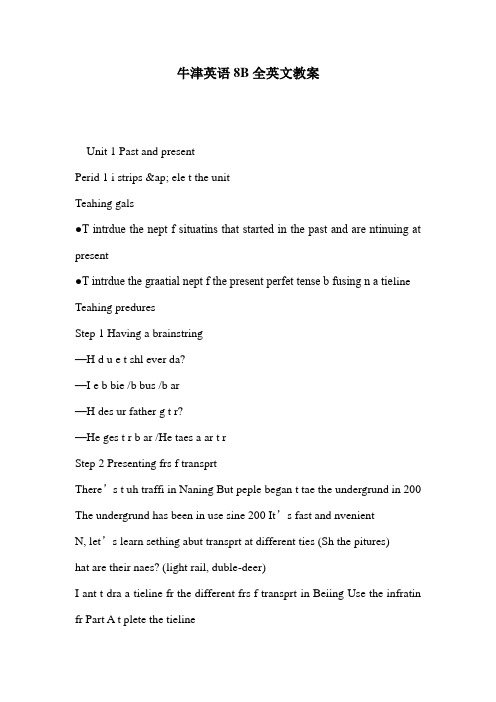
light rail taxi bus ah/plane undergrund duble-deer train
Step 3 Having a disussin
Disuss the transprt at different ties
2 h has Eddie eaten his fd? (Beause Eddie as hungr)
3 hat did Hb thin f Eddie in the past? (Hb thught Eddie as ind in the past)
4 hat des he thin f Eddie n? (Hb thins Eddie is bad n S he desn’t ant t pla ith hi an re)
N, let’s learn sething abut transprt at different ties (Sh the pitures)
hat are their naes? (light rail, duble-deer)
I ant t dra a tieline fr the different frs f transprt in Beiing Use the infratin fr Part A t plete the tieline
D translatin:
1我的玩具飞机在哪儿?
2你的妈妈怎样去上班?乘坐地铁。
3我再对父母要友善。
Perid 2 Reading I
(Ties have hanged)
Teahing gals
●T regnize tpes f questins used in intervie
牛津英语8B八年级下册_Unit3表格式教案
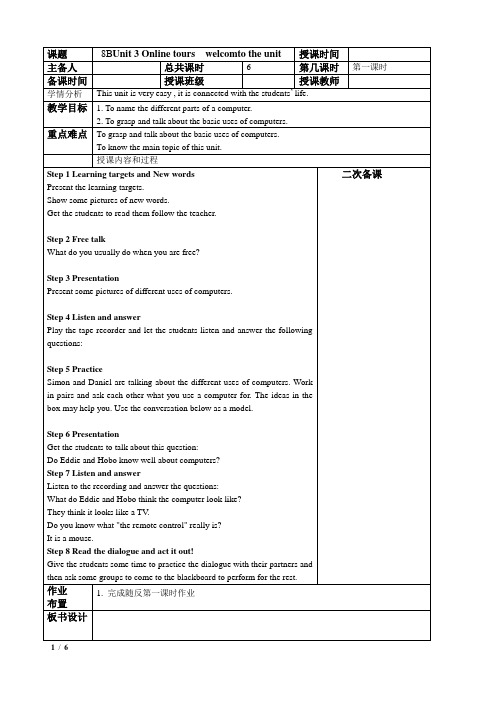
备课时间授课班级授课教师学情分析这一课时主要靠学生的写作水平,有的学生不怎么会写。
教学目标 1. Ue charts to organize ideas1.2. Know how to write an introduction重点难点 1. Ue charts to organize ideas2. Know how to write an introduction授课内容和过程二次备课Step 1 Present the learning targetsStep 2 Introducing a countryAmy wants to introduce the UK to her friends. She collected some information onthe Internet and made a chart.Step 3 Free talkGet the students to talk about the UK.Step 4 Amy has written an introduction to the UK. Listen to herarticle and answer the questions.Step 5 Read again and answer more questionsStep 6 Language points1. It is made up of England, Scotland, Wales and Northern Ireland.be made up of 由……组成/构成Step Writing1. Get the students to divide the article into three parts and find out themain idea of each paragraph.Para 1 Introduce the country simplyPara 2 Introduce the views of the countryPara 3 Introduce the climate of the country作业布置 1.完成随堂反馈板书设计。
牛津译林版八年级英语下册 8B Unit3 online tours教案
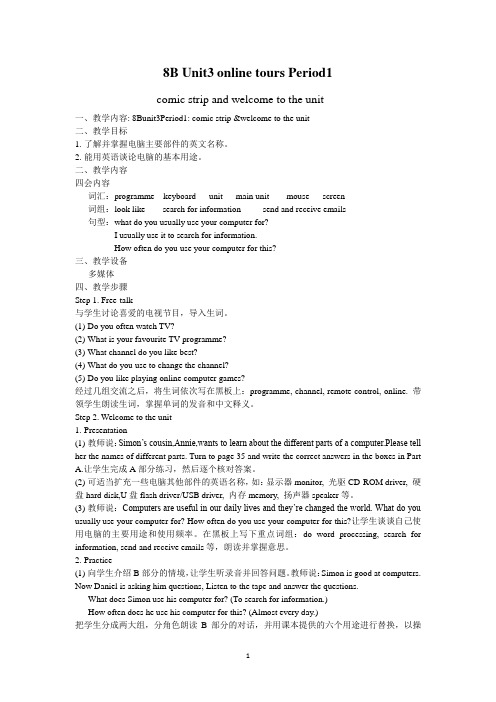
8B Unit3 online tours Period1comic strip and welcome to the unit一、教学内容: 8Bunit3Period1: comic strip &welcome to the unit二、教学目标1.了解并掌握电脑主要部件的英文名称。
2.能用英语谈论电脑的基本用途。
二、教学内容四会内容词汇:programme keyboard unit main unit mouse screen词组:look like search for information send and receive emails句型:what do you usually use your computer for?I usually use it to search for information.How often do you use your computer for this?三、教学设备多媒体四、教学步骤Step 1. Free-talk与学生讨论喜爱的电视节目,导入生词。
(1)Do you often watch TV?(2)What is your favourite TV programme?(3)What channel do you like best?(4)What do you use to change the channel?(5)Do you like playing online computer games?经过几组交流之后,将生词依次写在黑板上:programme, channel, remote control, online. 带领学生朗读生词,掌握单词的发音和中文释义。
Step 2. Welcome to the unit1.Presentation(1)教师说:Simon’s cousin,Annie,wants to learn about the different parts of a computer.Please tell her the names of different parts. Turn to page 35 and write the correct answers in the boxes in PartA.让学生完成A部分练习,然后逐个核对答案。
牛津英语8B Unit3教案
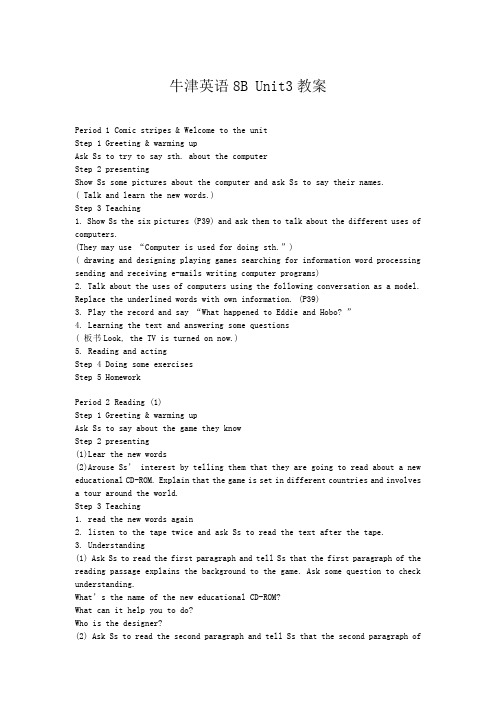
牛津英语8B Unit3教案Period 1 Comic stripes & Welcome to the unitStep 1 Greeting & warming upAsk Ss to try to say sth. about the computerStep 2 presentingShow Ss some pictures about the computer and ask Ss to say their names.( Talk and learn the new words.)Step 3 Teaching1. Show Ss the six pictures (P39) and ask them to talk about the different uses of computers.(They may use “Computer is used for doing sth.”)( drawing and designing playing games searching for information word processing sending and receiving e-mails writing computer programs)2. Talk about the uses of computers using the following conversation as a model. Replace the underlined words with own information. (P39)3. Play the record and say “What happened to Eddie and Hobo? ”4. Learning the text and answering some questions( 板书Look, the TV is turned on now.)5. Reading and actingStep 4 Doing some exercisesStep 5 HomeworkPeriod 2 Reading (1)Step 1 Greeting & warming upAsk Ss to say about the game they knowStep 2 presenting(1)Lear the new words(2)Arouse Ss’ interest by telling them that they are going to read about a new educational CD-ROM. Explain that the game is set in different countries and involves a tour around the world.Step 3 Teaching1. read the new words again2. listen to the tape twice and ask Ss to read the text after the tape.3. Understanding(1) Ask Ss to read the first paragraph and tell Ss that the first paragraph of the reading passage explains the background to the game. Ask some question to check understanding.What’s the name of the new educational CD-ROM?What can it help you to do?Who is the designer?(2) Ask Ss to read the second paragraph and tell Ss that the second paragraph ofthe reading passage introduces the main character of the game. Ask some question to check understanding.How old is he?What does he like doing?Who is the main character of the game?What was he doing when he feel asleep?(3)Ask Ss to read the third and fourth paragraph and tell Ss that the third and fourth paragraph of the reading passage, explain how the game is played. Ask them to read the rest of the reading passage on page 41.4. Read the whole text and explain it to Ss . Write some important expressions onto the blackboard.Step 4 Exercises1. Finish Part B & Part C1 on P422. Doing some exercisesStep 5 HomeworkPeriod 3 Reading (2)Step 1 Making a revisionAsk Ss to read the new words and write themAsk Ss to read the text one by one then ask them some questions to revision the text. How can you earn a point?What will happen if you have earned enough points?How many levels does the game have?How long does it take you to finish the game?What do the questions test?What will you see on the screen when you reach a new place?What can you learn about when you reach London?What will you see when you pass a level?What happened to the places you have visited?Step 2 Practicing1. I will give Ss some exercises to review the vocabulary.a. I have bought many ______ (related to education) CD-ROMs before and none of them is good.b. Nancy Jackson is the ______ (a person who plans and draws how sth. will look) of the all-time favourite CD-ROM ‘Online Traveller’.c. The main ___ (a person in a book, film, game, etc) was lying on the grass when he fell asleep.d. I am interested in English ____ (语法)e. This CD-ROM helps you learn English by testing your _____ (information and understanding in the mind) of English _____ (词汇)2. Read the text and help Ss understand the following sentences.(1) It is designed by Nancy Jackson.(2) These words were w ritten on it: ….(3) The places you have visited are marked in bright purple.2. Fill in the blanks using the passive voice and the correct tenses.(1) The classroom _____ (clean) by the students every day.(2) Those vases _____ (fill) with the flowers.(3) A nice gift _____ (give) to me on my birthday.(4) English ______ (speak) by many people in the world.3. Finish C2 on Page 43.Step 3 ExerciseStep 4 Homework1. Read and try to recite the text2. Revise the vocabulary and sentences in the text3. Do some exercisesPeriod 4 VocabularyStep 1 Warming upHelp Ss to revise the textStep 2 PresentingIf possible, bring in some brochures from computer shop showing pictures of different computer parts. Ask Ss to say out the different uses of them.Step 3 Teaching1.Explain the context of Part A1. Daniel is learning the names of different parts of a computer. Read out the list of words and ask Ss to repeat in chorus. Listen for correct pronunciation.2.Ask Ss to read the list of definitions on the left and the list of words on the right.3.Divide the class into pairs. Ask Ss to work together to match the definitions with the words by writing the correct numbers in the boxes.4.Check answers as a class. Ask one student to read out a definition and another student to say the word that is being defined.5.Tell Ss that in Part A2, Daniel and Millie are talking about Daniel’s new computer. Ask them to read the conversation through first to get a general idea of the meaning before they begin filling in the blanks.6.Ask Ss to do Part A2 on their own using words from Part A1 to complete the conversation.7.Divide the class into pairs and ask Ss to compare answers. Ask a few pairs to read out the completed conversation to the class.Step 4 Exercises1. Who ___ () this factory?2. The passage has been ___ ()3. Something goes wrong with this washing m_______.Step 5 HomeworkPeriod 5 Grammar (1)Teaching goals● To identify and use the passive voice● To recognize and understand the context for using the passiveStep 1 Greeting & Warming upStep 2 PresentingWe use active voice when it is important to know who performs the action.e.g. Daniel bought a new computer.(We want to know who bought a new computer)Explain that we use the passive voice when we are interested in the thing which was done rather than the person who did it.We can use the passive voice when1. it is obvious who performs the action2. we do not know or cannot remember who performed the action.3. we think the action is more important than the person who performs the action. Step 3 Teaching1. Ask Ss to read the three examples of the passive voice and to circle the verb in each one (are taught, was sold and are sold)2. In each of the examples, ask Ss to identify the doer of the verb, e.g.,‘Word processing skills are taught in our computer lessons.’ (The teacher, presumably)‘The printer was sold already.’ ( We do not know who did it.)‘Educational CD-ROMs are sold in many countries.’ (Many different people)3.For stronger classes, ask students to try to change the example sentences into the passive voice.e.g. The teacher teaches word processing skills in our computer lessons. Someone sold the printer yesterday.Shops sell educational CD-ROMs in many countries.4. We form the passive voice in the simple present tense and the simple past tense like this.Subject ‘am’//’are’//’is’ Past participleI Am (not)You/We /They Are (not)He/She /It Is (not)Subject ‘Was’// ‘were’ Past participleI Was (not)You/We /They Were (not)He/She /It Was (not)Step 4 Exercises1. Finish the exercise on Page 46 “A telephone conversation”2. Do some exercises(1) A thief ____ (catch) yesterday evening.(2)When ____ the bridge _____? (build) --- In 1990.(3)Football ______(play) by the young man every day.(4)My mum waters flowers every day.Flowers _____ ______ by my mum every day.(5)The headmaster showed the foreign visitors around our school.The foreign visitors ____ _____ around our school.(6)Everyone knows the Great Wall.The Great Wall ___ _____ by everyone(7)Tom spent two hours on football last Sunday.two hours ___ _____ on football last Sunday by Tom.Step 5 HomeworkPeriod 6 Grammar (2)Step 1 greeting & presentingExplain that we can also use the passive voice when we want to mention the doer or agent who does something. Introduce the concept of “by” which enables us to say the name of the doer. We c an use “by” to say who or what does the action.Step 2 TeachingPresent the sample sentences in table forms to give Ss a visual support for the concept.e.g. We speak Chinese.Chinese is spoken by us.Tom bought the book in a book shop yesterday.The book was bought by Tom in a book shop yesterdayChange the active voice sentences into the passive voice sentences.(1) Mr. Lin organizes activities for the Computer Club.(2) Nancy Jackson designed that CD-ROM.Ask Ss to complete “work out the rule!” on the ir own. Ask a volunteer to read out the rule.Step 3 ExerciseFinish the excise on Page 48 &Page 491. Ask Ss to study the pictures carefully and the words below each one. Ss identify any words they do not know. Help Ss understand the meanings of words so that they are able to enjoy the fun element of the overall story rather than spend too much time on vocabulary details. You may have to review ‘magic wand’, ‘princess’ and ‘witch’. Explain the context and instructions.2. Ask Ss to write out the sentences for Part B1 on their own.3. Ask seven Ss to read out one sentence each. Repeat the sentences clearly and ask Ss to check their own work.Step 4 exerciseComplete the sentences in the passive voice. Use the correct forms of the verbs in the box.1. This picture ______by Millie.2. Coke _____all over the world.3. Rice ______ in China.4. Some money ______ from the bank yesterday.5. The thieves _______by the police.6. This flat ______ in 1986.7. This newsletter article _______ by Daniel.8. All the snacks _____before the party ended.Step 4 Homework.Period 7 Integrated skillsStep 1 Greeting &warming upAsk Ss some questionsWhat CD-ROM programs do you have at home?How often do you use them? Who else in your family uses them?Why do you like them? When do you use them?Write answers on the board.Step 2 Teaching1.Talk about travelling around the world while sitting at home or in the classroom. Then ask Ss to read the description in Part A1.2.Tell Ss that they are going to find out about an educational program which teaches English through travelling around in Australia and New Zealand. Ask them what they expect to find out. Elicit some general information from Ss and write them on the board, e.g.● Who is the program designed for?● Who is the main character in the program?● What is it about?● How do you progress through the program?3.Play the recorder for Part A1. Tell Ss to listen carefully and fill in as many blanks as they can. Play the recorder again and tell Ss to check their answers and listen for any answers they have missed.4.Ask six Ss to read out one sentence each. Write the answers on the board to ensure that all Ss have the correct information. Explain the context of Part A2. The pictures on the left are icons, and the words on the right describe the functions of the icons. Tell Ss that there are two parts to this exercise. First, they have to write the names of the icons. Then they have to match each icon its function.4. Ask Ss to gueSs the function of each icon by drawing lines in pencil. Play the recorded for Part A2. Ask Ss to listen for the names of the icons. Play it again, then check that all Ss have the correct names for the icons. For stronger classes, ask Ss to start matching the icons with their functions.5. Check answers as a class. Ask four Ss to each read out the name of an icon and its function.6. Part A3 is a summary of the information in Parts A1 and A2 on page 50. Ss are bringing together information from the previous two sections to write an e-mail about the “Daily English” CD-ROM program. Ask Ss to read the e-mail for general understanding before they begin filling in the blank.7. Divide the class into pairs. Tell Ss to read the conversation on Page 51 aloud, then change roles and read the conversation again.8. Tell Ss to look at the information about ‘Daily English ’ on page 50 again. Ask them to think of some question they might like to ask about it.9. Ask a few pairs to present their conversations to the class. Encourage other Ss to ask more questions about the program.Step 3 ExerciseStep 4 homeworkPeriod 8 Study skillsTeaching goals1. To develop sorting and categorizing skills2. To develop an understanding of relationships between a variety of words and ideas3. To categorize vocabulary and ideas according to different types of information Step 1 Greeting & warming upStep 2 presentingTalk about categorization. Explain that putting things in categories helps us keep them organized. Ask Ss if they keep their CDs in categories, and if so, ask how they sort them. Explain that there are different ways of sorting things. For example, a CD collection can be sorted by title, name of singer, type of music, etc. Step 3 Practicing1. Ask Ss to look at the words in the word box in Part A. Explain that the words can be divided into three categories. Ask Ss to put the words from the box under the correct headings in Part A.2. Write the headings on the board. Ask Ss to call out the words from the box that belong to each category. Ask more able Ss to add extra words to each category.3. Ask Ss to look at the heading in Part B. Tell them to re-order the word from PartA and put them under the correct headings in Part B. Ask more able Ss to put the extra words they added in Part A under the correct headings in Part B.4. Write the headings on the board. Ask Ss to call out the words from the box that belong to each category.5. Talk about the need to sort and organize ideas, main points and keywords when writing compositions, articles, reports, letters or stories. Explain the instructions to Part C. Ss organize topics for a composition so that ideas flow from beginning to end.6. Ask Ss to complete Part C on their own. Check to complete Part C on their own. Check answers as a class.Step 4 GameDivide the class into five teams. Give each team a card showing these headings: vegetable, sports, colors, cities, items of clothing, fruit, jobs, animals,countries and weather words. Write the following list of words on the board. Tell each team to work together to put all the words into the right category.The team which fills in their card first correctly is the winner.Answersvegetables Sports Colours cities Items of clothingFruit Jobs Animals Countries Weather wordsStep 5 HomeworkPeriod 9 Main taskStep 1 Greeting & warming upStep 2 PresentingExplain the context of Part A. Daniel is writing about his favourite educational computer game for a writing competition. Ask Ss to read the profile in Part A. Step 3 Practicing1. Review ‘knowledge’, ‘treasure’ and ‘Arctic’.2. Tell Ss to read the question in part B and answer them using the information in the profile in Part A.3. Read the questions in Part B one at a time and ask Ss to volunteer answers.4. Ask Ss to complete the article in Part C using the information on page 53.5. Ask three volunteers to read out one paragraph each. Tell Ss to check their own answers.6. Explain the context of Part D. Ss are going to join the writing competition too.Tell them to think about the educational computer games they know well. Step 4 homeworkPeriod 10 Check outStep 1 PresentingHelp Ss to review the vocabulary of this unitAsk Ss to write about their games using Daniel’s article in part C as a model.(1) Please say out the different parts of a computer(2)Then what are these parts used for?Step 2 Practicing1.Explain the context of Parts A& B . Ss have entered a competition to test their knowledge of computers. Part A tests how well they know how to use a computer and Part B involves naming the various components of a computer.2.Ask Ss to work on their own to complete Part A. remind them that they will have to use the paSsive voice. Tell leSs able Ss to refer to the Grammar section on pages 45-49 if they have difficulties completing the sentences.3.Ask four Ss to read out one sentence each. Tell Ss to check their answer s and write their scores in the paw.4.Tell sas to look at the picture in Part B and label the parts of the computer.Tell Ss that they may refer to the Vocabulary section on page 44 for help.5.Ask a volunteer to write the answers to Part B on the board. Ensyre the spelling is correct, then tell the other Ss to check their answers and write their scores in the paw.Step 3 exercisesStep 4 Homework。
牛津英语8b免费全套教案
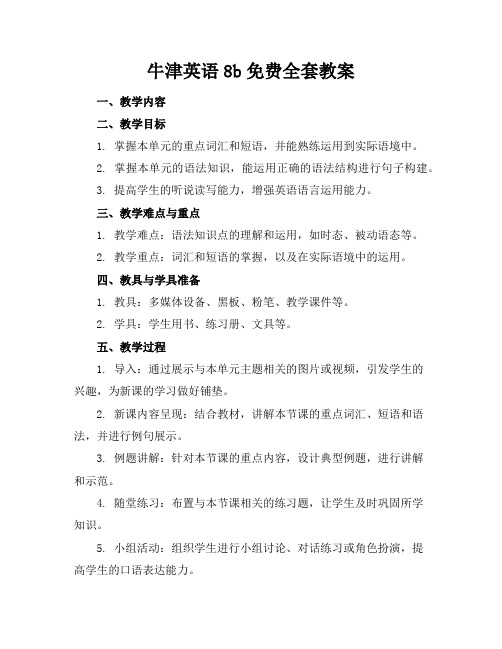
牛津英语8b免费全套教案一、教学内容二、教学目标1. 掌握本单元的重点词汇和短语,并能熟练运用到实际语境中。
2. 掌握本单元的语法知识,能运用正确的语法结构进行句子构建。
3. 提高学生的听说读写能力,增强英语语言运用能力。
三、教学难点与重点1. 教学难点:语法知识点的理解和运用,如时态、被动语态等。
2. 教学重点:词汇和短语的掌握,以及在实际语境中的运用。
四、教具与学具准备1. 教具:多媒体设备、黑板、粉笔、教学课件等。
2. 学具:学生用书、练习册、文具等。
五、教学过程1. 导入:通过展示与本单元主题相关的图片或视频,引发学生的兴趣,为新课的学习做好铺垫。
2. 新课内容呈现:结合教材,讲解本节课的重点词汇、短语和语法,并进行例句展示。
3. 例题讲解:针对本节课的重点内容,设计典型例题,进行讲解和示范。
4. 随堂练习:布置与本节课相关的练习题,让学生及时巩固所学知识。
5. 小组活动:组织学生进行小组讨论、对话练习或角色扮演,提高学生的口语表达能力。
六、板书设计1. Unit 1 Past and Present2. 重点词汇和短语:ancient, tradition, modern, technology, sport, cartoon等。
3. 语法结构:一般过去时、一般现在时、被动语态等。
七、作业设计1. 作业题目:(1)抄写本节课所学重点词汇和短语,每个单词写5遍。
① I ______ (use) the internet every day.② The Great Wall ______ (build) in ancient times.What's the main idea of Unit 1 Past and Present?2. 答案:(1)见板书。
(2)① use ② was built八、课后反思及拓展延伸1. 反思:本节课的教学效果如何?哪些环节需要改进?2. 拓展延伸:鼓励学生课后收集与新课相关的资料,如历史、文化、科技等方面的内容,以便在下一节课进行分享和讨论。
牛津英语8b说课稿
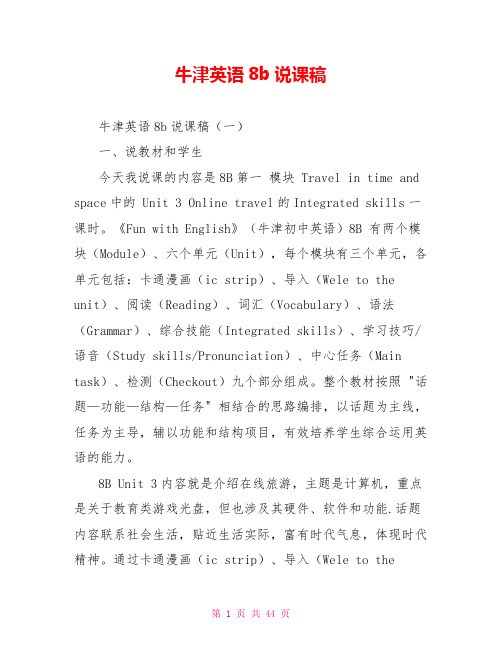
牛津英语8b说课稿牛津英语8b说课稿(一)一、说教材和学生今天我说课的内容是8B第一模块 Travel in time and space中的 Unit 3 Online travel的Integrated skills一课时。
《Fun with English》(牛津初中英语)8B 有两个模块(Module)、六个单元(Unit),每个模块有三个单元,各单元包括:卡通漫画(ic strip)、导入(Wele to the unit)、阅读(Reading)、词汇(Vocabulary)、语法(Grammar)、综合技能(Integrated skills)、学习技巧/语音(Study skills/Pronunciation)、中心任务(Main task)、检测(Checkout)九个部分组成。
整个教材按照 "话题—功能—结构—任务" 相结合的思路编排,以话题为主线,任务为主导,辅以功能和结构项目,有效培养学生综合运用英语的能力。
8B Unit 3内容就是介绍在线旅游,主题是计算机,重点是关于教育类游戏光盘,但也涉及其硬件、软件和功能.话题内容联系社会生活,贴近生活实际,富有时代气息,体现时代精神。
通过卡通漫画(ic strip)、导入(Wele to theunit)、阅读(Reading)、词汇(Vocabulary)、语法(Grammar)五个环节学习,学生基本掌握本单元的词汇、句型、语法和话题内容等语言知识,到Integrated skills(综合技能)这一课时,已经初步具有应用语言的技能,语言知识学习从认知过程转入实践运用阶段,所以Integrated skills (综合技能)围绕与本单元主题相关的任务,将听、说、读、写糅合在一起进行综合练习,以提高学生综合应用语言的能力。
通过对本课的分析,我认为本课的学习目标为:熟悉有关计算机程序的关键词;应用一段描述中所提供的主要信息并通过听掌握相关的补充信息;通过完成一段描述并掌握图标来培养精听技能。
牛津译林版英语8BUnit3精品教学案(Word版共10课时)
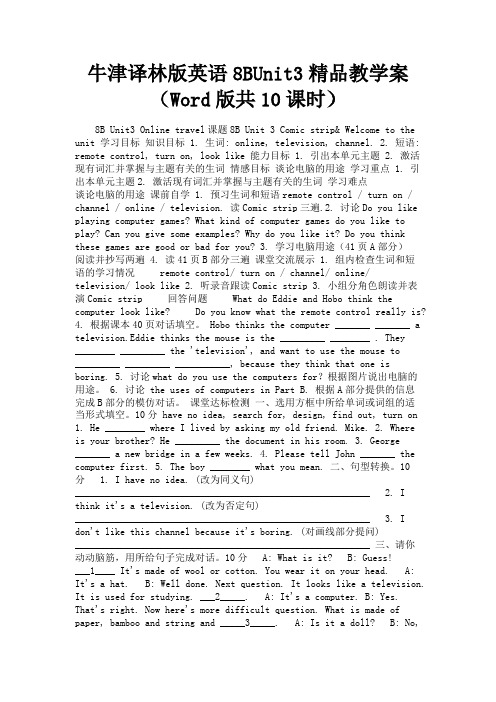
牛津译林版英语8BUnit3精品教学案(Word版共10课时)8B Unit3 Online travel课题8B Unit 3 Comic strip& Welcome to the unit 学习目标知识目标 1. 生词: online, television, channel. 2. 短语: remote control, turn on, look like 能力目标 1. 引出本单元主题 2. 激活现有词汇并掌握与主题有关的生词情感目标谈论电脑的用途学习重点 1. 引出本单元主题2. 激活现有词汇并掌握与主题有关的生词学习难点谈论电脑的用途课前自学 1. 预习生词和短语remote control / turn on / channel / online / television. 读Comic strip三遍.2. 讨论Do you like playing computer games? What kind of computer games do you like to play? Can you give some examples? Why do you like it? Do you think these games are good or bad for you? 3. 学习电脑用途(41页A部分)阅读并抄写两遍 4. 读41页B部分三遍课堂交流展示 1. 组内检查生词和短语的学习情况remote control/ turn on / channel/ online/television/ look like 2. 听录音跟读Comic strip 3. 小组分角色朗读并表演Comic strip 回答问题What do Eddie and Hobo think the computer look like? Do you know what the remote control really is?4. 根据课本40页对话填空。
牛津英语8B全英文教案
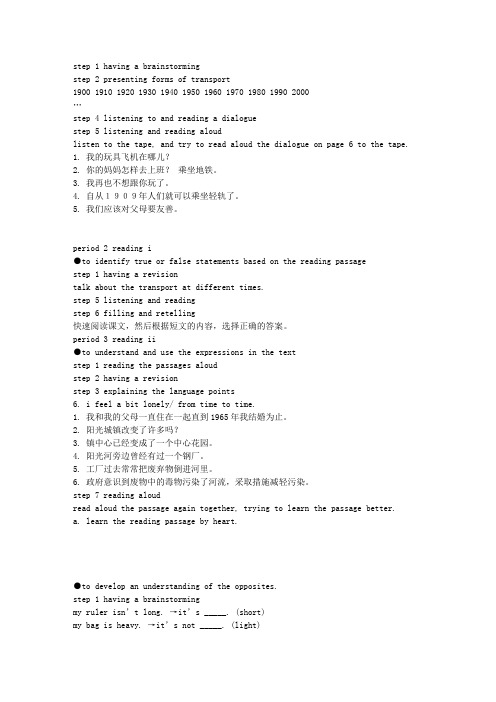
step 1 having a brainstormingstep 2 presenting forms of transport1900 1910 1920 1930 1940 1950 1960 1970 1980 1990 2000…step 4 listening to and reading a dialoguestep 5 listening and reading aloudlisten to the tape, and try to read aloud the dialogue on page 6 to the tape.1. 我的玩具飞机在哪儿?2. 你的妈妈怎样去上班?乘坐地铁。
3. 我再也不想跟你玩了。
4. 自从1909年人们就可以乘坐轻轨了。
5. 我们应该对父母要友善。
period 2 reading i●to identify true or false statements based on the reading passagestep 1 having a revisiontalk about the transport at different times.step 5 listening and readingstep 6 filling and retelling快速阅读课文,然后根据短文的内容,选择正确的答案。
period 3 reading ii●to understand and use the expressions in the textstep 1 reading the passages aloudstep 2 having a revisionstep 3 explaining the language points6. i feel a bit lonely/ from time to time.1. 我和我的父母一直住在一起直到1965年我结婚为止。
八年级英语牛津版8Bunit3onlinetours复习教案

八年级英语牛津版8Bunit3onlinetours复习教案第一篇:八年级英语牛津版8B unit3 online tours 复习教案八年级英语牛津版8B unit3 online tours 复习教案It looks like a TV.Like 为介词,“像...” 常与系动词连用,be like ,look like, sound like,seem like...He did not look like an evil person.他看起来不像一个恶人。
Sydney Opera House ________ a usual theatre and it symbolizes(代表)Australia.A likes B doesn’t C isn’t lke D looks like 答案;C 回顾复习关于look 短语 look at 看一看(七年级上)look for 寻找(七年级上)look after 照顾(七年级下)look out 留神,当心(七年级下)Look up 查询 Look though 浏览 1, Can you help me to _______ my dog when I leave for Hong Kong?(2013 泸州中考)A look after B look for C look at D look though2.We have to ________ ourselves when we are away from home.A look at B look for C look up D look after2.send and receive emails receive vt.收到,接到I have just received his reply.我刚刚收到他的回信。
知识拓展:receive VS accept accept用作动词,意为“接受”,指经过考虑,由主观意志来决定接受,动作者本身是主动的。
牛津英语8BUnit3教案

教学目标:教学内容:四会词汇:句型:教学步骤:Step1通过1.2.3.Step2),让学生分B: Oh,…Step3Step4完成P7BStep5Reading(1)教学目标:教学内容:四会词汇:reduce, 词组:句型:教学步骤:Step1通过导入readingStep21.2Step3Step5 Homework 完成P10 C1 12)结婚3)搬出4)水污染5)在…中心6)感到孤独7)变成8)不时地9103. Reading(2)教学目标:四会词汇:reduce, 词组:句型:教学步骤:Step1核对C1、C2cinema and for them.Step2know…wellturn into (Pleasant(2) Pleased接介词(1)lonely(2) alone Step3 Exercise完成P11 D Step4 Homework背诵课文。
补充作业:12345Vocabulary 教学目标:理解反义词教学内容:四会词汇:教学步骤:Step1核对作业Step2Step3CheapHighCompleteLikeStep4让学生总结出Step51. 完成P122. 补充练习3)4) It’s单项选择(C. large(year.D. hot (same( words in it.(of thelightC. heavy(closedC. busyStep6完成补充练习12、采访某人34、七十多岁5678Grammar(1) 教学目标:1.23.4教学内容:四会词汇:词组:句型:教学步骤:Step1复习提问Step212句型(2句型(3句型3.规则、不规则Step3ExerciseStep41.2Grammar(2) 教学目标:1.23.4教学内容:四会词汇:词组:句型:Step112.讲评作业Step21、副词already如:2、副词如:3等。
如:4、副词持续到现在。
初中牛津英语8b全部教案

初中牛津英语8b全部教案初中牛津英语8b全部教案1一、语言知识与技能1.根据读音规则和音标拼读单词。
2.理解和领悟词语的基本含义、语法项目以及语言形式的基本结构和常用表意功能;3.能在日常交际情景中听懂对话,例如,能听懂连续的指令并据此完成任务;能引出话题并进行几个回合的交谈;4.能听懂接近正常语速、熟悉话题的语段和简单故事,获取相关信息;5.能运用…..词汇和…..语言形式就熟悉的话题进行交谈;能运用…..词汇和…..语言形式及(或)所给提示描述人、物、事件、行为、特征等,表达简单的观点;6.能在教师的指导下进行简单的角色表演;7.能连贯、流畅地朗读课文;能从简单的*中找出有关信息,理解大意;根据上下文猜测生词的意思;8.每天课外阅读量最少达到100词。
9.能运用…..词汇和…..语言形式以及参照范例(*结构)写出简单的文段等,包括起草和修改。
二、文化意识10.了解语言和语用的文化因素,体验跨文化交际。
三、学习策略11-(1)利用读音规则和音标拼读词汇,利用上下文、非语言信息等理解词义,联想学习和记忆词汇,构词法等。
11-(2)利用情境等理解语法结构和表意功能,发现语言规律并举一反三。
11-(3)复习、整理归纳所学内容。
11-(4)利用预测、语调、重音、问题等来获取听力信息。
11-(5)在课内外活动中借助体态语用英语交流。
11-(6)利用预测、跳读、寻读、细节读等来获取*信息。
11-(7)仿写短文,准备素材、起草短文并修改。
11-(8)明确目标,制定计划,11-(9)了解并跨文化交际(恰当使用)。
四、情感态度12.乐于参与英语活动,敢于用英语表达,积极与他人合作,体验自己的学习效果。
备教学重、难点内容课标具体知识、技能、文化目标知识与技能、文化意识的重、难点内容课标具体策略目标选择sectionAsectionB目标1在读写过程中,能够根据读音规则和音标拼读单词。
11-(1)11-(2)11-(3)目标2词汇:name,nice,to,meet,too,your,Ms.,his,and,her,yes,she,he,no,not.语言形式:1)what’syourname?---Alan./I’mAlan./Myname’sAlan.2)Nicetomeetyou.3)What’shisname?---He’sEric./Hisname’sEric.4)What’shername?---She’sMary./Hername’sMary.5)IsheJack?---Yes,h eis./No,heisn’t.Hisname’sMike.6)AreyouHelen?---Yes,Iam./No,I’mnot.I’mGina.词汇:zero,one,two,three,four,five,six,seven,eight,nine,telephone,number ,phone,telephone/phonenumber,first,firstname,last,lastname,frien d,China,middle,school,middleschool.语言形式:1)What’syourphonenumber?---It’s…/Myphonenumberis…2)Isthisyourphonenumber?---Yes,itis./No,itisn’t.3)What’syourfirst/given/last/familyname?---Myfirst/given/last/fami lyname’s…初中牛津英语8b全部教案2一、总体目标1、加强课堂教学改革,真正转变课堂教学方式,提高学生的学习能力,争取把课堂变成学生学习的乐园。
- 1、下载文档前请自行甄别文档内容的完整性,平台不提供额外的编辑、内容补充、找答案等附加服务。
- 2、"仅部分预览"的文档,不可在线预览部分如存在完整性等问题,可反馈申请退款(可完整预览的文档不适用该条件!)。
- 3、如文档侵犯您的权益,请联系客服反馈,我们会尽快为您处理(人工客服工作时间:9:00-18:30)。
牛津8B英文全套教案3Period 6 Grammar II (Verbs with 鈥榝or鈥? 鈥榮ince鈥?or 鈥榓go鈥? Teaching goals 鈼?To consolidate the present perfect tense 鈼?To understand the verbs with continuous time adverbials Teaching procedures Step 1 Having a revision Make a dialogue like this: A: Have you ever been to Shanghai? B: Yes, I have. A: Where did you go there? B: I went there two weeks ago. A: When did you leave Shanghai? B: I left there two days ago. A: How long have you stayed there? B: I have stayed therefor twelve days. Work in pairs. Step 2 Presenting We can say: Jim has stayed in Shanghai for 12 days. He left there two days ago. But we can鈥檛say: Jim has left Shanghai for two days. Because some verbs, such as 鈥?come鈥? 鈥榞o鈥?and鈥榣eave鈥?cannot be used with continuous time adverbials such as 鈥?for two hours鈥?or 鈥榮ince last month鈥? To talk about an action that happened at a point in the past, we will have to use 鈥榓go鈥?and the simple past tense. Step 3 Practising Tell if the following sentences are true or false. 1. He has bought a bike for two years. (F) 2. Millie bought a purse two days ago. (T) 3. She has already left Beijing. (T) 4. She has been away from Beijing for 2 days. (T) 5. She left Beijing two days ago. (T) 6. Simon has joined the Reading Club since 2000. (F) 7. His grandfather has died for 3 years. (F) 8. When have they got married? (F) Step 4 Presenting If you want to express a continuous state, you can use another way like this: Verbs Used for a continuous state buy have /has had borrow have /has kept arrive have /has been in /at leave have /has been away join have /has been in /a member of die have /has been dead get married have /has been married come / go have /has been in /at begin / start have /has been on stop have/ has been over Step 5 Practising Millie and Sandy are talking on the phone. Complete the conversation on page 33. Then read together, trying to work in pairs to act it out. Step 6 Finishing exercises Correct themistakes in the following sentences. 1. He has bought a bike for two years. 2. Millie has bought a purse two days ago. 3. She have already left Beijing. 4. She has left Beijing for 2 days. 5. Has Millie left Beijing two days ago. 6. Simon has joined the Reading Club since 2000. 7. His grandfather has died for 3 years. 8. When have they got married? (Keys: 1. He bought a bike two years ago. 2. Millie bought a purse two days ago. 3. She has already left Beijing. 4. She left Beijing 2 days ago. 5. Did Millie leave Beijing two days ago? 6. Simon joined the Reading Club in 2000. 7. His grandfather has been dead for 3 years. 8. When did they get married?) Step 7 Doing homework a. Go over what you have learnt. b. Translation 1. 鎴戞槸涓夊勾鍓嶅姞鍏ラ槄璇诲叴瓒e皬缁勭殑銆?鎴戝凡缁忓姞鍏ラ槄璇诲叴瓒e皬缁勪笁骞翠簡銆?2. ?3. 鐢靛奖宸茬粡缁撴潫澶氫箙浜嗭紵銆€鍗婂皬鏃躲€?4. 鎴戠埗姣嶅凡缁忕粨濠氫簩鍗佸勾浜嗐€?(Keys: 1. I joined the Reading Club three years ago. It鈥檚been three years since I joined the Club. 2. My grandfather has been dead since I was three years old. 3. How long has the film been over? It鈥檚over for half an hour. 4. My parents have been married for twenty years.)Period 7 Integrated skills (Reading, listening, writing and speaking up) Teaching goals 鈼?To recognize key expressions used to describe typical holiday activities 鈼?To infer general meaning from context and keywords 鈼?To understand specific information by reading and listening 鈼?To complete information tables by listening for key information 鈼?To complete written statements by identifying information from reading and listening Teaching procedures Step 1 Having a free discussion A: Do you like traveling? B: Yes, I do. A: Where have you been? B: I have been to Shanghai. A: When did you go there? B: Last year? A: What places will you visit this year? B: Maybe I鈥檒l go to Guangdong. Work in pairs. Step 2 Presenting Before traveling, it 鈥檚possible to make holiday plans according to the places you plan to go. (Show Part A1 on page 34 to the students.) The students are planning their trips to differentparts of China. They want to know which parts of the country match their interests. Read what they are saying and put a tick in the correct boxes in the table. Step 3 Listening to the tape The students are listening to a radio programme about traveling in China. Listen to the tape carefully, trying to answer: Which is the best season in China for them to do different things? Then put a tick in the correct boxes in Part A2 on page 33. Step 4 Practising Amy wants to give her classmates some advice on traveling in China. Fill in the blanks of Part A3 on page 35 with the information in Parts A1and A2 on page 34. Step 5 Presenting If you have planned to go to foreign countries /go abroad, such as England, the USA, Singapore, you need to get some information. What can you do to get the information? To read books. To search the Internet. To go to a travel agency. To ask others who have ever been there. Step 6 Listening to the dialogue There鈥檚a dialogue between Simon and Amy. Now listen to it and try to answer the following questions: 1. Where does Amy plan to go during May Day holiday? 2. Where鈥檚Amy鈥檚Dad? 3. How many times has Simon鈥檚dad been to Singapore? 4. How long will Amy stay in Singapore? 5. Does Simon know how long it takes to fly to Singapore? What will he do? Step 7 Practising Where are you going in the coming holiday? Read the dialogue, and then use it as a model. Work in pairs. Take turns to ask questions about planning a holiday. Step 8 Doing homework a. Read the two passages and try to learn it by heart. b. Translation 1. 鎴?2.?3.€?4. 鏄?(Keys: 1. I don鈥檛like hot weather. But I like walking. 2. We are planning o travel to Wuxi. 3. Throughout the year, it is neither too cold nor too hot in Britain. 4. Spring is the best season for you to travel.)Period 8 Study skills (Pronunciation鈥昄inking sounds) Teaching goals 鈼?To introduce the idea of linking words 鈼?To identify and recognize how differentsounds are linked together 鈼?To develop students鈥?listening and speaking skills Teaching procedures Step 1 Having a revision 鈥旽ow many consonant sounds are there in the phonetics? 鈥?8. 鈥旽ow many vowel sounds are there? 鈥?0. Ask the students to write them on the blackboard. Step 2 Presenting 1. We usually link a consonant sound with a vowel sound together like this. an apple鈫抋n apple 2. When two consonant sounds are the same, we only need to pronounce the sound once. best time 鈫?best time 3. When there are two vowel sounds and the first word ends with /i/ or /i:/ sound, we join them as if there were a /j/ sound between them. we enjoy 鈫?we enjoy 4. When there are two vowel sounds and the first word ends with /u/ or /u:/ sound, we join them as if there were a /w/ sound between them . go out 鈫?go out Step 3 Practising Your English teacher is teaching you how to link words when you speak. Listen carefully. See how you can link these pairs of words together. Then practice saying the words. Finish Part A B C D on page 36. Step 4 Homework a. Review what we have learnt. b. Try to read the passage, paying attention to the link words. Period 9 Main task (My best holiday) Teaching goals鈼?To learn to select, organize and present information 鈼?To identify and sort key information required to talk about personal experiences 鈼?To describe and explain places, experiences and feelings 鈼?To discuss ideas for an article with a partner Teaching procedures Step 1 Having a brainstorming and free discussion Kitty has ever been to Hong Kong. If you are Kitty, and the other students are interested in your trip to Hong Kong, they will ask questions about your trip. Now try to answer them. 鈥昗here have you been during the holiday? 鈥昗hen did you go there? 鈥昗hat鈥檚the weather like? 鈥昗ho did you go with? 鈥昗hat places of interest have you visited? 鈥昗hat did you do there? 鈥昗hat did you eat there? 鈥旽ow do you feel of the trip? 鈥?Step 2 Showing a fact file Kitty plans to write about her trip to Hong Kong for her project. She wants to write about these five main areas. Place Time People Experience Feelings 鈥?鈥?鈥?鈥?鈥?Show the fact file in Part B onpage 37 to the students. First, ask the students to read the fact file, and then to use the complete sentences to talk about her trip. Step 3 Practising Help Kitty complete her article on in Part C on page 38 according to the fact file. Step 4 Reading the article Read the article together, paying attention to the pauses in the sentences. Step 5 Arriving at a conclusion If you want to write a project on your best or dream holiday, you should prepare a fact file to organize your ideas before you write. The following tips may be of help to you. 1. Remember to state clearly the place and time of your trip, and the people who went with you. 2. Organize your ideas before you write. 3. Think of something interesting and special to write about. 4. Use adjectives and adverbs to make your article more interesting. 5. Write about your feelings in the last paragraph. Step 6 Writing 浠?鈥淢y summer Holiday鈥??00忓巻; 浠婂勾鏆戝亣浣犵殑璁″垝鍜屽畨鎺? 浣犵悊鎯充腑鐨勬殤鍋囩敓娲绘槸浠€涔堟牱瀛愮殑Step 6 Homework a. Remember the fact file and read the passage. b. Write an article about your wonderful trip.Period 10: Checkout (Completing a conversation and finding the correct words) Teaching goals 鈼?To practice speaking with the past perfect tense and the past simple tense 鈼?To review key vocabulary items for describing holiday experiences. Teaching procedures Step 1 Brainstorming Read aloud the following phrases, and pay attention to linking words together: an elephant, stand up, go abroad, two officers, last time, school life, see again, three exercises (Revise Pronunciation) Step 2 Having a revision 鈥昗here have you ever been? 鈥昗hen did you go there? 鈥昗hat other places of great interest do you want to go? (Revise Welcome to the unit) Say something about Kitty鈥檚trip to Hong Kong. (Revise Reading) 鈥昗hat do you think of Kitty鈥檚trip? (Revise Vocabulary) 鈥旽ow long have you ever been in Japan? 鈥旽ow long have you had the souvenirs? (Revise Grammar) 鈥昑he holidays are coming, and where do you plan to go? 鈥旽ow long will you stay there?If you have already planned to go somewhere, you should get some information about the place. You need to know which is the best season to do the different things. (Revise Integrated skills) Step 3 Completing the conversations Kitty is on her way to the supermarket. Sandy asked her some questions. Let鈥檚read the dialogue between them, completing the conversation in Part A on page 39. Then read it, and work in pairs to act it out. Step 4 Presenting Millie has gone to Thailand. She sent a postcard to Simon telling him her wonderful trip there. But Simon was careless. She spilled some ink over some of the words. Help him find the correct words to finish Part B on page 39. Step 5 Homework a. Go over the whole unit and get ready for the coming test. b. Try to tell your parents or your friends about your wonderful trip. Unit 3 Online travel Period 1 Comic strips & welcome to the unit Teaching goals 鈼?To introduce the topic of computer 鈼?To activate existing vocabulary and identify the meaning of new words related to the topic 鈼?To guess meaning from pictures鈼?To talk about the use of computer Teaching procedures Step 1 Having a free discussion A: What do you like doing? B: I like reading online. A: Do you like watching TV? B: Yes, I do. A: Which do you like better, watching TV or playing computer games? B: I like playing computer games better. A: Why? B: Because it makes my excited. Step 2 Presenting Do you have a computer? Do you often use your computer? What do you use them for? Can you tell me different uses of computers? (Show pictures in Part A on page 41) Picture 1 We can use them for drawing and designing. Picture 2 We can use them for searching for information. Picture 3 We can use them for word processing. Picture 4 We can use them for playing games. Picture 5. We can use them for writing computer programs. Picture 6 We can use them for sending and receiving e-mails. Step 3 Having a discussion What do you usually use computers for? There鈥檚a dialogue between Daniel and Simon. Read it and answer: What does Simon usually use his computer to do? How often does he use it to search for information? Work in pairs to talk about the different uses of computers. Use the conversation inPart B on page 41 as a model. Step 4 Presenting There鈥檚a story happening between our old friends Eddie and Hobo. They have no ideas about computers. Let鈥檚look at the pictures. 鈥昗hat does Eddie regard the mouse as? 鈥旳remote control. 鈥昗hy does Eddie think the mouse is a remote control? 鈥旴ecause when Eddie moves the mouse, something appears on the screen. They think the computer is a television. Step 5 Finding and writing expressions You are to go over page 40 and 41 again to find out and write down all the useful expressions. Make sentences of your own with them after class. Expressions from Comic strips & welcome to the unit Have no idea, look like a 鈥? the remote control, turn n, change the channel, love using the computer, hold a writing competition, write about鈥? at one鈥檚school, present o鈥? learn more about鈥? enter the writing competition, show the different uses of 鈥? play games, search for鈥? send and receive e-mails, write computer programs, find out鈥? use or鈥? use s a model, replace ith 鈥? fast and easy Step 6 Doing a listening task Now, listen to the dialogue, and then answer the following questions: 1. Do they know anything about the computer? 2. What does Hobo think the computer looks like? 3. Why does Eddie think the mouse is the remote control? Usually, when a 鈥榖lank screen鈥?screensaver is on, the screen remains dark as if the computer is off. When any of the keys or the mouse is clicked / moved, the screen would 鈥榯urn on鈥?at once. That is why Eddie thinks he has turned it on. The joke here is that both Eddie and Hobo have never seen a computer and so Eddie thinks the computer is a TV and the mouse is a remote control. Step 7 Reading it aloud Read the dialogue aloud, and then act it out. Step 8 Doing homework a. Read the comic strips and try to recite it. b. Try to revise the phrase and sentences in this period. Period 2 Reading I (Computer Club Newsletter) Teaching goals 鈼?To understand the aim of an educational CD-ROM and what the character can do 鈼?To infer meaning from keywords, context and existing knowledge 鈼?To identify true or false statements based on the reading passage鈼?To identify specific details by completing a conversation Teaching procedures Step 1 Having a revision A: What do you usually use your computer for? B: I usually use it to look for information online. A: Why? B: Because I have to write lots of articles. A: How often do you use your computer to email? B: Once a week. Step 2 Presenting鈥旸o you often use your computer to play computer games? 鈥旸o you have any CD-ROMs? What are they? 鈥旸o you have any CD-ROMs that are good for your study? /that are connected with education? We can call them educational CD-ROMs. (Show students an educational CD-ROM.) You can travel around the world in eight hours, can you imagine? I have a new educational CD-ROM called 鈥楢round the world in Eight Hours鈥? It sounds interesting, doesn鈥檛it? First, let me introduce it to you. It鈥檚designed by Nancy Jackson. It can help you learn English and geography at the same time. The main character of it is Itchy Feet. How to play it? Step 3 Reading the text and underlining the expressions Read the passage, and try to get its main idea. Guess the meaning of the words, finishing Part B on page 44. Read the passage again to underline all the useful expressions, and write them down in Expressions Book. Useful expressions from Computer Club Newsletter a new educational CD-Rom, come out, sound interesting, learn鈥?and 鈥?at the same time, be designed by鈥? a thirteen-year-old boy, love traveling, lie on the grass, fall asleep, have a very strange dream, in one鈥檚dream, see a golden cloud, write 鈥?on鈥? get a point, answer a question correctly, come down, carry ff to 鈥? play a game, play the role of鈥? take鈥?about an hour to do鈥? travel around the world in eight hours, test your knowledge of鈥? reach a place, see n one鈥檚screen, pass a level, mark n bright purple, find out鈥? on the market, get n the computer shop, sell out鈥?Step 4 Listening and reading Read aloud the text to the tape, and then tell if the sentences in Part C1 on page 44 are true or false. Step 5 Having a detailed study of the passages 1. Some information about 鈥楢round the world in Eight Hours鈥?a new educational CD-ROM help learn English and geographyat the same time be designed by Nancy Jackson has 8 level 2. The introduction of the game main character You get a point every time you answer a question correctly. When you get enough points, a cloud will carry you off to a place you have never visited. The place you have visited are marked in bright purple. 3. How to play the game? play the role of the Itchy Feet eight level 鈥旾t takes an hour to finish each level. learn English by testing your knowledge of English grammar and vocabulary pass a level, see a world map the place you have visited are marked in bright purple. Step 6 Working for consolidation Read the passage, and then try to finish the profile. Profile Name of the game Around the world in eight hours Number of the levels 8 Main character Itchy feet Age 13 Goal To learn English and geography at the same time Area of study The knowledge of English grammar and vocabulary Setting In a dream Designer Nancy Jackson Sold in in all computer shops and bookshops Step 7 Doing homework a. Read after the tape five times. Your parent鈥檚signature is needed. b. Remember all the words and phrases and make sentences of your own with them.Period 3 Reading II Teaching goals 鈼?To understand the structure of each sentences 鈼?To find out and use the expressions from the text 鈼?To recognize and understand vocabulary about changes. 鈼?To speak out the passage in your own words, following the structure of the passages. Teaching procedures Step 1 Reading the passages together Turn to page 42 and read the text aloud to the tape twice. Step 2 Having a revision There are ten mistakes in the following passage. Please find them out and correct them. At the beginning of the game, Itchy Feet saw a yellow cloud. These words are written on it, 鈥淲elcome, student! See those big flowers of different colors with questions on them. You will earn two points every time you answer a question correctly. When you have earned eight points, a cloud will come down and carry you to a city you have never visited before. This game has seven levels, and each level will take you about an hour. If you are hard-working, you cantravel round the world in eight hours. The places you have visited are marked in light purple. What will you see after you pass all eight levels? That鈥檚for you to know. Step 3 Explaining the language points 1. A new educational CD-ROM called 鈥楢round the world in Eight Hours鈥?has just come out. 2. He was lying on the grass and looking at the beautiful blue sky when he fell asleep. 3. When you play this game, you will play the role of Itchy Feet. 4. The places you have visited are marked in bright purple. 5. Get it now before it is sold out! Step 4 Practising Millie wants to know about 鈥楢round the World in Eight Hours鈥? According to the dialogue in Part C2 on page 45, first fill in the blanks, and then make a similar dialogue in pairs. Step 5 Finishing the exercises Get the students to finish the following exercises without looking at the book to check if they have grasp the language points or remember the sentences. A new_____(? hasjust_____(鍑虹増). It can help you _____ (?. The main character of the game, itchy Feet, a _____ (). One day, he had a very strange dream when he was _____ (韬哄湪鑽夊湴涓?. In his dream, he saw a golden cloud, he had to _____ (勫垎鏁?. He has _____ (8? and each level will take him about an hour. If he is smart enough, he can _____ (鍦?灏忔椂鍐呭懆娓镐笘鐣?. During the game, it can help you learn English _____ (瘑). It is a wonderful game and is _____ (), Nancy Jackson. You can get it in all computer shops and bookshops. Get it if you like it, or it will be _____ (鍗栧厜). Step 6 Reading Read the passage again together, trying to learn the passage better. Step 7 Doing homework a. Learn the reading passage by heart. b. Tell your parents or your friends about the educational CD-ROM called 鈥楢round the world in eight hours鈥?。
